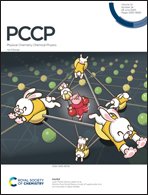C–F and C–H bond cleavage mechanisms of trifluoromethane ions in low-lying electronic states: threshold photoelectron–photoion coincidence imaging and theoretical investigations
Abstract
Dissociative ionization of trifluoromethane (CHF3) is investigated in the 13.9–18.0 eV energy range using the threshold photoelectron–photoion coincidence (TPEPICO) technique coupled to a vacuum ultraviolet synchrotron radiation source. Four electronic states of CHF3+, i.e., the X2A1, A2A2, B2E, and C2E states, are populated upon ionization. In this energy range, the parent CHF3+ ions fully dissociate. For the CHF3+ ions in the ground state, the analysis of the time-of-flight profile of the unique CF3+ fragment ions suggests statistical dissociation. For the electronically excited CHF3+ ions, the C–F bond cleavage preferentially occurs to predominantly produce CHF2+ + F. Moreover, all TPEPICO images of the CHF2+ ions exhibit identical patterns, with a weak central spot revealing a previously unobserved statistical decomposition pathway, and the predominant ring in the images documents a fast nonstatistical dissociation channel. The unimolecular decomposition mechanisms of the CHF3+ ions are illuminated with the aid of the one-dimensional potential energy curves along the C–H and C–F coordinates calculated using the time-dependent density-functional theory. Moreover, a comparison of the dissociation dynamics of CHF3+ in these low-lying states with those of CF3Cl+ strongly suggests a substituent effect of chlorine atoms on the binding structure.



 Please wait while we load your content...
Please wait while we load your content...